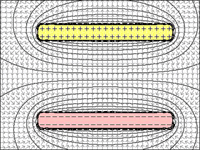So my friend and I were working on this project which required capacitors. We needed to charge a capacitor with the following rating: 100microFarad, 400V.
When we connected it to a 220V AC source (peak voltage 311V) it went boom. We thought we had somehow shorted the circuit and tried once again making sure that the connections were proper. Once again it went boom. What were we doing wrong? Our setup was simply a few wires and our capacitor.
EDIT
So I got why it blew up (the current surged). Now I'm editing the question to ask this:
So while we were in school, our physics laboratory assistant called up an electrician from downstairs to show how to do stuff. The electrician brought a ceiling fan capacitor and showed us how to connect it to the socket. Maybe he thought we were dealing with such capacitors too. So he charged the capacitor and took it out and touched its two ends in such a way that there was sparking (proof of charging). Why didn't this capacitor blow up? Current must have surged in this one too right? (Thank God it didn't blow up! The guy was holding it in his palms). There wasn't any considerable difference in capacitance (it was 1000 microfarad against the 100microfarad we used) so why didn't it?

Best Answer
Your 100uF 400V capacitors were undoubtedly low cost aluminum electrolytic capacitors rated only for use on a DC circuit. When you connect such capacitor to the AC mains you are alternately subjecting the component to a positive peak of the 311V and then -311V at a rate of some 50 or 60 times per second. The polarized plates in the electrolytic capacitor very quickly break down under these conditions and can lead to an internal short.
Even if the capacitor plates were able to survive the negative voltage for a short time the effective AC impedance of a 100uF capacitor connected to the AC mains without many other series components to limit the current would result in a goodly amount of power being dissipated in the component resulting in the sealed can expanding and exploding.